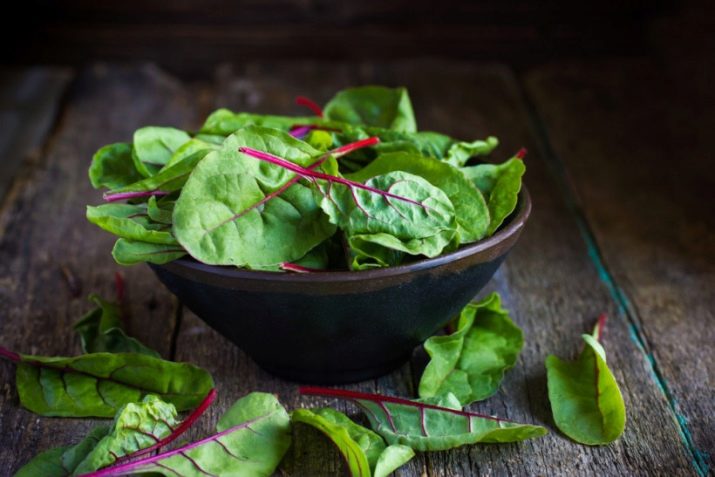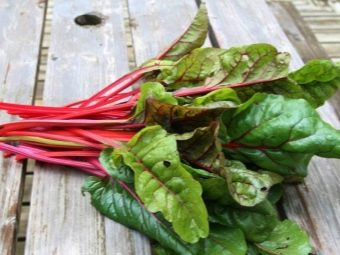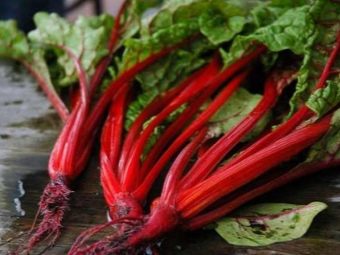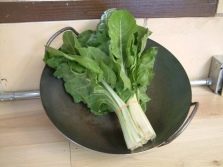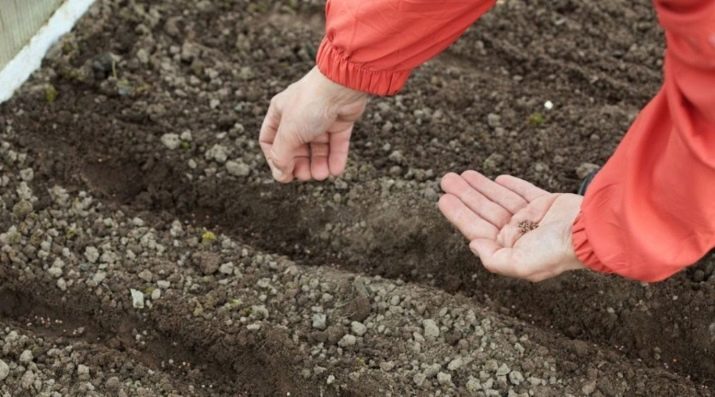"Chard": features and rules of cultivation
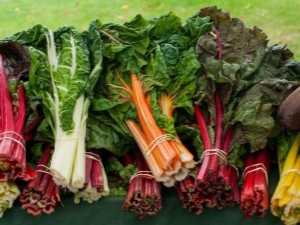
There are a large number of vegetable crops, which at one time were not widespread and are only gaining momentum today. These types of plants include “Mangold”, whose body benefits and taste have led to its active cultivation in gardens, summer cottages, and even on balconies and window sills of city apartments and houses.
What it is?
Initially, this plant was quite actively used in food in ancient Rome and Greece, but for some time the demand for Mangold decreased compared with beetroot, and the first culture was almost forgotten.
However, leaf beets (more simple name "Mangold") stands out for its unique composition and unpretentiousness in the course of cultivation in the open field, at home or in greenhouses. Now the plant is a worthy competition to crops such as celery or spinach. The leaves of "Mangold" have excellent taste, due to which the vegetable can be eaten both fresh and after heat treatment.
According to reviews, salads, all kinds of first courses and pies with the use of vegetable culture acquire a delicate and unique taste.
By its chemical composition, the plant is much better than red beet, but, unlike its close relative, Mangold only uses petioles and tops. As for the root, even after heat treatment, it remains hard and completely devoid of taste. However, he found use - rhizome is used as a nutritional supplement in the diet of domestic cattle.
Sheet beets can produce crops throughout the year: in warm weather, the crop can be grown in the open field, and planted in the winter in the greenhouse or at home.
"Chard" refers to the family of blooming, as many scientists believe, the birthplace of the plant is Western Europe. Beetroot is a two year old crop. In the first season, she forms an erect rosette of leaves of various color and size. Green wavy type, bubbly leaves, round and heart-shaped. The stalks of "Mangold" reach a height of about 25 centimeters. The stem is quite powerful, but at the same time brittle.
The plant blooms in small green or whitish buds, collected in a ball. Usually they bloom in May in the second year of culture.
Harvesting begins in June and lasts until November, with regular cutting of leaves and petioles to activate the development and growth of new beet greens. In the southern regions, the roots for the winter are left in the ground, due to which, next season, with the arrival of spring, the plant forms a juicy and vitaminized foliage.
"Chard" is of two types:
- stem;
- sheet.
The first type is distinguished by large and dense petioles, usually their diameter is about 5 centimeters. The taste of herbs resembles asparagus. Thanks to the successful work of plant breeders, vegetable growers were able to plant various varieties of this crop, whose color is striking in its diversity. That is why the product is quite popular for eating, not only in light of its health benefits, but also due to the attractive appearance of the dishes when using it.
The stalks of the first type of vegetable culture are eaten extremely rarely in their raw form, they are mostly boiled, and then boiled in breadcrumbs in butter. In addition, the stalks serve as an ingredient for first courses or vegetable stews.
Sheet "Mangold" stands out for its lush mop of leaves, this type of foliage is very large and reaches a length of about 45-50 centimeters. The color of the above-ground part of the plant depends on the variety, it can be green with various patches and shades.
Schnitt chard is best eaten fresh, in order to get the maximum amount of useful elements contained in the product.
If the foliage is necessary for the preparation of any dishes that involve heat treatment, the work must be done as quickly as possible so that the grass does not have time to lose its taste and does not lose its attractive appearance.
It is possible to prepare for the winter leaf and stem “Mangold” by freezing it. Thus, it is possible to save almost 100% of the beneficial micro and macro elements that make up it. In addition, it is possible to make the harvesting of a vegetable by pickling it, salting or pickling.
The main highlight of "Mangold" is foliage.
Based on its color, the following plant varieties can be distinguished:
- green beet;
- silver-chery;
- red-pebble;
- jaundice.
Due to the outstanding color palette of the existing varieties of beets, it can be used to prepare original, nutritious and beautiful dishes.
Beneficial features
Some vegetable growers mistakenly compare the taste and the benefits of "Mangold" with the beets from ordinary beets. Since the difference in taste characteristics and useful qualities from the use is enormous, which makes it impossible to draw analogies between these two products.
To make the most complete picture of the positive features of the plant, it is necessary to allocate the main vitamins that are in the composition of leaf beets. Culture is rich in vitamin K, which normalizes metabolic processes in the tissues of the human body, in addition, ensures the proper functioning of the kidneys.
Of great importance is the level of ascorbic acid, its value is within 33%, which is comparable with the level of vitamin C in green onions. That is why “Chard” is recommended to be used in the offseason and winter to strengthen the immune system and maintain healthy skin and hair.
The product contains an excellent antioxidant, represented by vitamin AHe is responsible for improving vision, in addition, stands out a huge benefit for the female body. The vegetable is remarkable for its thiamine and vitamin B content, which respond to the normal functioning of the nervous system. Plant culture has many trace elements, among which iron, manganese, sodium, calcium and copper should be distinguished.
According to studies, it was found that the "Mangold" contains about nineteen polyphenolic antioxidants that promote the removal of toxins and purify the body. The introduction of vegetables in the diet reduces the likelihood of developing malignant tumors, helps strengthen bones and teeth. In addition, beet is recommended as a product to exclude the incidence of diabetes and anemia.
Plant culture is indicated for the following diseases:
- disorders of the pancreas;
- greens are recommended to be eaten during the recovery period after surgery;
- "Mangold" is indicated for obesity;
- menopausal women;
- foliage is introduced into the diet with complex treatment of depression and other disorders of the nervous system;
- to increase the immunity of the body;
- foliage is used in cosmetology for skin rejuvenation;
- beet greens have a healing effect with burns and abscesses;
- in addition, the product normalizes the processes of digestion.
Contraindications
Despite the colossal benefits, Mangold has some negative properties. First of all, it concerns the content of oxalates in the product. Such substances do not allow to fully absorb calcium in the body, which provokes the formation of kidney stones. People suffering from this disease, with the introduction in the diet of green leaf beets should be especially careful.
In addition, despite the enormous benefits of vitamin K, its excessive content can cause blockage of blood vessels.Freshly squeezed vegetable juice can not be added to vegetable cocktails, because it will help to reduce blood pressure, as a result, dizziness, vomiting, and so on. This reaction is due to the presence of volatile compounds that evaporate during the process of mechanical processing of the culture.
To exclude harm from contact with them, the juice should be given some time to insist, after which it will be suitable for drinking.
Popular varieties
Given the characteristics of the culture, when choosing a variety, it is necessary to give preference to cultures that have clear recommendations regarding the climatic characteristics of a particular region for cultivation.
You can select more popular varieties of leaf beets.
- "Mangold the Scarlet" - refers to the early ripening crops, the harvest can be collected in a month. The plant is distinguished by large leaves with a purple tinge and crimson petioles.
- "Charley" - You can collect foliage from a plant in a month and a half. Plant has a green color with a red tint.
- "Mirage" - mid-season leaf beets, allowing to harvest 50-55 days after planting. The length of the leaf with the stem can reach 50 centimeters. The color of culture is dominated by green.
- "Ruby" - late-ripening crop, greens can be consumed 85 days after the appearance of the first shoots. The leaves of the plant have a rich red color, the stems are dark green.
- Belavinka - variety of Swiss sheet beet, which gives a harvest closer to 80 days after germination. The height of the culture reaches quite impressive size - about 70 centimeters. Beetles have white petioles, and the foliage has a rich green color. This variety stands out for its cold resistance.
Subtleties breeding and care
Agrotechnical measures concerning "Mangold" do not include any labor-intensive processes, this is due to the unpretentiousness of the culture and its resistance to negative temperatures.
However, it is possible to grow beets from planting material only in well-heated soil, although the appearance of the first shoots can be waited at a soil temperature of about + 6C. But the most acceptable soil for development will be when heated to + 20C.
As for frost resistance, the young culture retains its viability at –1 ° C, and the more mature plants withstand frost resistance to –5 ° C.
By selecting the appropriate variety of leaf beets, you can proceed to the preparatory work that relate to the seeds. Before planting, they must be kept for several days in a damp cloth or soaked in a growth stimulator.
"Mangold" is better planted seedling. Usually planting seeds for seedlings is carried out in the middle - end of March. Upon reaching the cultures of the month they can already be sent to the garden or grow on a balcony or windowsill.
If the seeds are sown immediately in open ground, it is best to do it in the middle of May, and for early sowing to make a cover from the film.
For growing crops, it is worth picking a well-lit area with a normal soil pH. The plant needs fertilizer, quite good culture responds to the introduction of organic matter. This may be charcoal, which will help in case of need to reduce the acidity of the soil.
When sowing immediately in the garden to deepen the seeds need to 2 centimeters in increments between plants of 5 centimeters. After a while, the seedlings must be thinned out, so that the distance between the bushes doubled.
You can plant Mangold in three terms:
- in the first case, the landing time falls on the end of April;
- in the second version of the work can be carried out closer to the middle of summer;
- In addition, beets can be planted before winter.
As for the care of beets, it is worth noting that the culture belongs to moisture-loving plants, in addition, the introduction of fertilizers should be regular. Once every week and a half, the soil is fed with infusions of herbs or with a solution of mullein.Loosening the soil and weeding weeds are carried out as needed. The plant tolerates the heat, but the optimum temperature for it will be + 25C.
In early-ripened crops, the harvest can be obtained one month after the emergence, and regular harvesting of the foliage will intensify the growth of new greenery. It is best to cut about a quarter of the foliage together with the petioles for one gathering from the bush. With the arrival of frosts, it is recommended to dig up the plant and send it to the basement or cellar in a box with sand.
In addition, for the winter culture can be planted at home. But for this, beets must be taken with a part of the land from the garden in order for it to better adapt.
What to put on the same bed?
As for the closest neighbors in the garden, you should avoid placing Mangold along with spinach. You should not plant a plant near the beans or corn.
However, the culture feels great if onions, carrots or lettuce grow nearby. A good companion for beets will be cabbage or garlic. In addition, the latter will scare off insect pests. Well, if the mint grows next to the "Mangold", with its leaves you can mulch the beds with beets.
It is worth noting the high decorative component of the green mass of culture, due to which the beets are planted not only in the garden, but also in flower beds and flower gardens.
How to eat it?
How to cook "Mangold", each housewife or cook decide independently based on personal preferences and skills. It is used as an ingredient for fresh salads and cold soups, leaves are stewed, boiled and fried. Quite often, culture canned or kvass. In addition, the leaves can be pickled as separate from other vegetables, and together, for example, with cabbage.
Petioles stand out for their delicate taste, they are often boiled, and then fried in oil.
Fresh foliage should be eaten immediately, since it retains its properties in the refrigerator for no more than two days. And when boiling it is necessary to pour out the resulting broth, because it contains nitrates.
Sheet beets are in perfect harmony with other vegetables, meats and cheeses. In addition, from the juice you can get fresh, but subject to the recipe for cooking.
The benefits of beet "Mangold" described in the next video.










